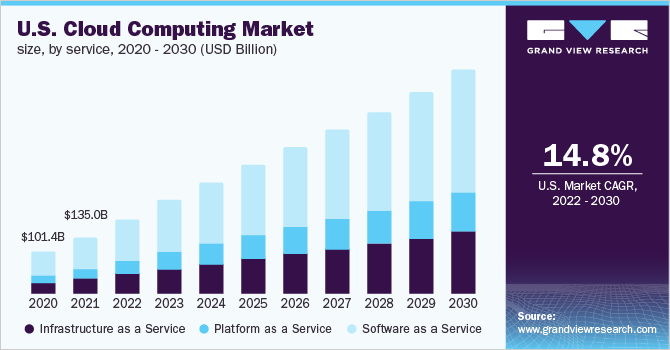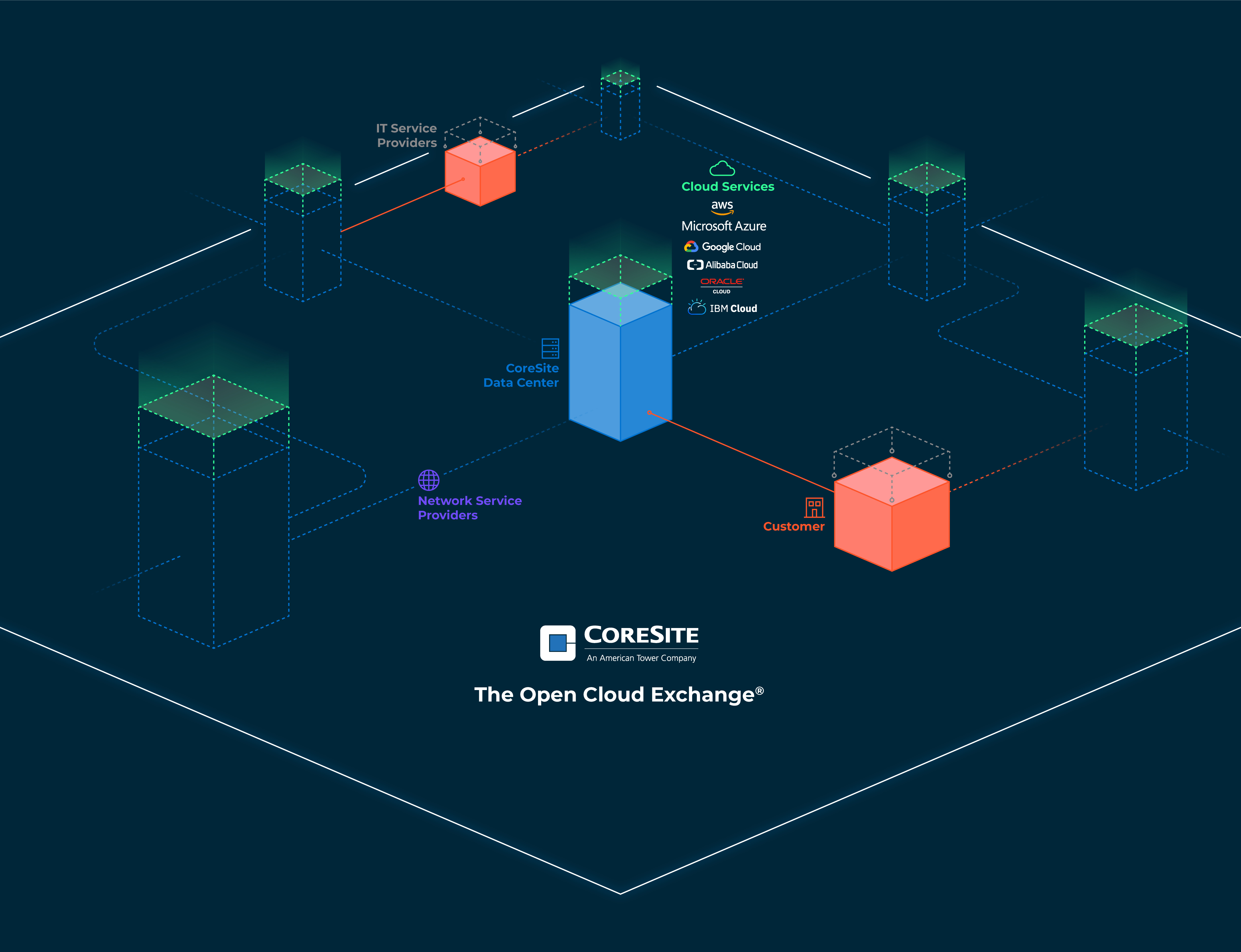
Top Public Cloud Service Provider Highlights and Connectivity Tips
Enterprises increasingly turn to hybrid IT strategies as they pursue digital transformation (DX). Hybrid IT environments can include a mix of private cloud, public cloud, hybrid cloud, colocation, multicloud and on-premises elements. Private cloud and public cloud are close in terms of enterprise adoption (70% and 68%, respectively).¹

In 2022, the global public cloud services market was expected to grow by approximately 22%. Grand View Research reported that of the three cloud computing segments – IaaS, PaaS and SaaS – SaaS accounted for more than 54% of services-driven revenue in 2021.
Here, let’s focus on the top public cloud service providers, which were growing rapidly even before hybrid IT became a well-known term. This overview of AWS, Microsoft Azure, Google Cloud Platform and Oracle Cloud provides highlights of their services to date.
You’ll also learn about the benefits of direct cloud connection – a private, highly secure and low-latency interconnection enabled through a cross connect in a data center. You’ll sometimes see direct cloud connect referred to as “native cloud onramp” when you continue to explore its purpose in hybrid IT.
Amazon Web Services (AWS)
Amazon Web Services (AWS) offers 200+ products and cloud services in categories such as compute, storage, database, analytics, machine learning and security. More than 15 industry-specific solutions exist for sectors such as advertising and marketing, financial services, media and entertainment, energy, automotive and education. Additionally, you can sort solutions by use case, industry and organization type. Some of the highlights are:
- Payment options such as pay-as-you-go, one- to three-year commitments and volume discounts, although you can opt to access AWS services using the free tier.
- Get-started support includes free training, tutorials and a video series on a variety of topics related to “how to build” in the cloud.
- The Developer Center and Architecture Center provide tools, documentation and resources.
- An extensive community-authored content library that contains blogs, videos, slide decks and podcasts.
- AWS Auto Scaling monitors applications and adjusts capacity automatically.
Microsoft Azure
The Azure cloud platform consists of 200+ products and services that allow you to build, run and manage applications in multiple clouds. You can explore solutions by use case, industry and organization type. Azure boasts industry-specific solutions for healthcare, financial services, government, retail and manufacturing. Reference architectures, customer enablement tools and the Azure Marketplace catalog of certified apps and services can streamline implementation. Highlights are:
- 90+ compliance offerings from PCI, FedRAMP, HITRUST, CSA to multiple ISO offerings.
- Some services are always free; others are free for 12 months.
- Videos, demos, webinars, training materials and documentation are available to help you get started and to migrate workloads.
- Azure Cognitive Services enable you to incorporate artificial intelligence (AI) services into your applications.
- Azure sales specialists assist customers with solution design, proof of concept, portal setup and migrating applications to the cloud.
Google Cloud Platform
Google Cloud touts its commitment to open source, multicloud and hybrid cloud, which allows customers to run applications on any cloud and in any environment. The platform offers more than 100 products. Industry-specific solutions include public sector, telco, media, entertainment, gaming, manufacturing, retail, healthcare and financial services. Google Cloud promotes its net carbon neutrality and defense-in-depth multilayer security. A few of the highlights are:
- Machine learning and analytics that deliver data insights.
- Encryption is applied to data in transit and at rest.
- Compliance offerings reflect global standards and can be sorted by region.
- Google Workspace offers chat, email, video calling and document collaboration apps.
- Pay-as-you-go pricing offers savings based on monthly usage, and rates are discounted for prepayment.
Oracle Cloud
Oracle Cloud Infrastructure (OCI) offers more than 80 services spanning IaaS, PaaS and SaaS. You can explore OCI with a 30-day free trial and review the always-free services, which are organized into categories of infrastructure, databases, observability and management, and additional services. OCI solutions are presented in an overview, by scenario and by industry.
- Several subscription options are available, including a bundled approach, bring your own license and metered/nonmetered services.
- Administrators, developers and architect can access free training and certification courses or attend free live sessions.
- The Oracle Cloud and Microsoft Azure Interconnect facilitates migration to a multicloud environment.
- The Architecture Center stores 100+ cloud use cases that you can customize and repurpose.
- Extensive guidance for modern application development touches on topics such as core requirements, design principles and technology recommendations.
Direct Connection to Public Cloud Service Providers Improves Outcomes
While connection to public cloud providers via the internet is a familiar path, it isn’t the best path when you consider performance degradation caused by spikes in usage, outages and security vulnerabilities – and due to the fact that the internet actually is comprised of many interconnected networks that aren’t operating at the same level.
The alternative? Bypass the internet. Connect to your cloud providers with private, secure, high-performance, direct-connect onramps:
- AWS Direct Connect
- Microsoft Azure ExpressRoute
- Google Cloud Interconnect
- Oracle Cloud Infrastructure FastConnect

At CoreSite, the Open Cloud Exchange® (OCX) is the connectivity starting point, whether you’re connecting within the colocation facility or using inter-site or inter-market connectivity. The OCX platform allows you to automate service provisioning, improve operations and increase business opportunities:
- Save up to 70% on data egress rates.*
- Increase performance with connections up to 100 Gbps.
- Connect with an ecosystem of enterprises and service providers (cloud, network and IT) to increase market reach and revenue.
Digital Transformation and Hybrid IT Continue to Drive Public Cloud Adoption
According to a recent study, 99% of respondents are using at least one public or private cloud, and 43% of enterprises combine multiple public and private clouds.³ Enterprises often use more than one public cloud provider to meet requirements for different applications and workloads.
After you make cloud provider decisions, evaluate your connectivity choices. Direct, private cloud connections offer substantial benefits, and the right colocation provider enables you to move data among cloud providers. And consider the value of access to a digital ecosystem whose members offer data protection platforms, data storage, carrier services, staffing services, telephone/VOIP services, sales enablement, managed IT services and much more.
Know More
Digital transformation takes a village. Explore the CoreSite Marketplace to find potential partners that can ease your business into new markets and introduce new efficiencies.
And, learn a lot more by getting your copy of 5 Reasons to Directly Connect Your Hybrid Cloud Solution e-book.








